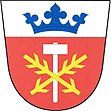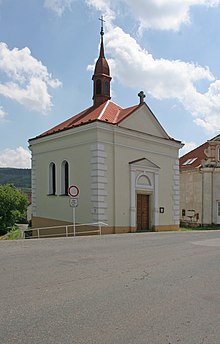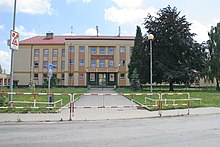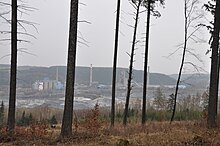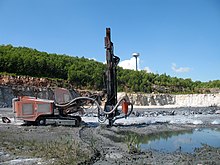Prachovice
| Prachovice | ||||
|---|---|---|---|---|
|
||||
| Basic data | ||||
| State : |
|
|||
| Region : | Pardubický kraj | |||
| District : | Chrudim | |||
| Area : | 532 ha | |||
| Geographic location : | 49 ° 54 ' N , 15 ° 38' E | |||
| Height: | 456 m nm | |||
| Residents : | 1,434 (Jan 1, 2019) | |||
| Postal code : | 538 04 | |||
| License plate : | E. | |||
| traffic | ||||
| Street: | Třemošnice - Heřmanův Městec | |||
| Railway connection: | Přelouč – Prachovice | |||
| structure | ||||
| Status: | local community | |||
| Districts: | 1 | |||
| administration | ||||
| Mayor : | Bohuslava Čepová (as of 2018) | |||
| Address: | Chrudimská 50 538 04 Prachovice |
|||
| Municipality number: | 572071 | |||
| Website : | www.obecprachovice.cz | |||
Prachovice (German Prachowitz ) is a municipality in the Czech Republic . It is located five kilometers northeast of Třemošnice and belongs to the Okres Chrudim .
geography
The village of Prachovice, surrounded by extensive forests, is located to the left of the Habřinka brook (Baukalker brook ) in the Iron Mountains ( Železné hory ). Prachovice is the terminus of the Přelouč – Prachovice railway line . An extensive limestone quarry extends on the Boukalka hill to the east of the village, while the cement works are located to the northeast. In the southeast rise the Bučina (606 m nm) and the Kozí hřbet (535 m nm), southwest of the Prachovický kopec (485 m nm) and in the northwest of the Na Kobylách (537 m nm).
Neighboring towns are Na Obíckách, Vyžice and Kostelec u Heřmanova Městce in the north, Tasovice and Nerozhovice in the northeast, the desert of Boukalka and Vápenný Podol in the east, Nutice, Hrbokov, Holín, Mezný, Kovářov and Seč in the south, Starýan in the south, Kraskov and Skoran in the south Dvůr and Podhradí in the south-west, Ohrádka, Rudov, Žlebské Chvalovice and Žlebská Lhotka in the west and Pazderna, Zbyslavec, Míčov and Sušice in the north-west.
history
It is believed that the village emerged from a quarry settlement for the construction of the Lichtenburg . Prachovice was first mentioned in writing in 1398 under the Lichtenburg family . When the Lichtenburg rule was divided, the village was assigned to the Stolany estate in the 16th century . In 1608 Emperor Rudolf II sold the Stolany manor to Ladislaus Berka von Dubá , who united it with the Heřmanův Městec manor . After the death of the childless Johann Dietrich Berka von Dubá, the rule of Heřmanův Městec with the Stolany estate fell to his sister Anna Maria Josephine von Khysl in 1636 . In 1661 she sold the rule to Johann von Sporck . After the death of Johann Wenzel von Sporck , the rule was sold to Philipp Anton von Greiffenclau in 1798 , and from 1828 it belonged to Prince Kinsky .
In 1835 the village of Prachowitz , located in the Chrudim district , consisted of 46 houses in which 361 people lived. The authorities maintained a Hegerhaus, a wood yard and two lime kilns in the village. The limestone sticking out of the mountains near Prachowitz was regularly quarried and produced good limestone and marble. The main sources of income were agriculture, animal husbandry, breaking and burning of lime and lime transport services. The parish and school location was Podol . Until the middle of the 19th century Prachowitz remained subject to the allodial rule Heřmanmiestetz.
After the abolition of patrimonial formed Prachovice / Prachowitz 1849 with the hamlet Boukalka / Baukalka a municipality in the judicial district Chrudim . In 1865 school lessons began in rented premises in Prachovice. The one-storey schoolhouse was completed the following year. From 1868 the municipality belonged to the political district of Chrudim . In 1881 the school building was extended. In the years 1881–1882 the Přelouč – Kalkpodol railway was built with a freight branch line from Tasovice to Prachovice. At the same time, the Čáslav – Závratec railway line and a five-kilometer funicular from Count Kinsky's limestone quarry near Prachovice to the Závratec lime works and the Závratec station were built. In 1910 the village had 838 inhabitants. On June 10, 1920, after 18 years of efforts by the municipality, the ČSD also started passenger traffic on the section between Tasovice and Prachovice. At the 1921 census there were 734 people in Prachovice. In the same year a primary school for economics was opened in the school building. After the action of the German occupiers against the base of the partisan brigade Mistr Jan Hus near Lipovec , around 17 partisans found refuge in Prachovice from January to April 1945.
In 1947 Prachovice was connected to the electricity supply. Because of the expansion of the limestone quarry, the village of Boukalka was relocated in the 1950s. In the course of the construction of the cement works, 280 apartments were built for employees in Prachovice. In 1957 the cable car to Závratec was dismantled. In the same year a new school was built and the old school building was demolished. The kindergarten was completed in 1959 and the sports stadium was inaugurated in 1964. With the support of the cement works, 32 single-family houses were built in the 1970s. Because of the enlargement of the limestone quarry, a new road connection to Vápenný Podol was established in 1975, which leads south around the Bučina. The social program associated with the construction of the second cement plant in Prachovice u. a. for the construction of 128 modern apartments, an accommodation house with 160 beds and a health center. In the 1980 census, 1,236 people lived in the 190 houses in the village; 118 of the houses were single-family houses. The Cementář Culture House was opened in 1981. In 2011 the passenger train service between Heřmanův Městec and Prachovice was discontinued.
Community structure
No districts are shown for the municipality of Prachovice. Part of the Boukalka desert belongs to Prachovice.
Lime extraction and processing
The extraction and processing of the limestone probably began with the construction of the Lichtenburg. The rock was broken to dust until the middle of the 19th century and burned in open wood-burning ovens. In 1864 Josef Klimpl built a ring furnace ; In the same year a company for lime production was formed in Prachovice under the name "První spolek k vyrábění vápna ve Vápenném Podole". A cylinder furnace was built in 1873 .
On behalf of Count Kinsky on Heřmanův Městec, the Austrian Local Railway Company built a funicular from Kinsky's limestone quarry to Závratec station in 1881, which at the time was the longest in Bohemia with a length of five kilometers. In 1891 the Viennese entrepreneur David Berl took over the transport cableway together with the Závratec lime works; Count Kinsky had leased the limestone quarry to Berl on a long-term basis in 1882. There was also another important lime quarry entrepreneur, Josef Musil. In the 1920s the lime distillery in Prachovice was operated by the J. Musil & Son company. In 1932, because of an illness, Josef Musil handed over his company to D. Berl - Kalkbrüche based in Prague. Since D. Berl's limestone quarries were increasingly producing inefficiently at this time, the company sought to merge with the lime works of the Bohemian Trading Company in Vápenný Podol to form a joint stock company. After the aryanization of the D. Berl company based in Prague in 1939, Königshofer Cement-Fabrik AG took over their limestone quarries. The Prachovická cementárna a vápenice, np was formed from the Prachovice limestone quarries of the Králodvorské cementárny as , which was nationalized in 1945 , and subordinated to the České cementárny a vápenice (CEVA). In 1949 the building permit for a cement factory and a lime kiln including the relocation of parts of the railway line, the access roads and the Habřinka, the expansion of the limestone quarry and the creation of a slope as well as the construction of a housing estate for the employees. The cement factory started regular operations in April 1956 with some delay, and the new lime kiln went into operation in 1958.
A second cement factory was built in Prachovice between November 1974 and June 1980 due to the steadily increasing consumption of cement. At the same time, the old factory was modernized. The increase in fuel and energy prices, technical problems with the parallel operation of the old and the new works as well as an overestimation of future cement requirements led to the old works being shut down and conserved at the beginning of 1981, and later gradually demolished. With the overburden of the lime quarry, the Podol lime quarries have been backfilled since 1976 .
After the Velvet Revolution , the cement plant was separated from GŘ CEVA Praha in January 1990 and initially run as an independent state-owned company. In March 1991, the company was converted into a state-owned joint-stock company with the aim of privatization. In January 1992 the Swiss Holderbank Financière Glarus AG acquired a third of the shares, in the following years it bought further blocks of shares and thus acquired the majority. The company has been part of Holcim since 2002 , which it sold to Cemex in 2015 .
With an area of 111 ha, the Prachovice limestone quarry is now one of the largest in the Czech Republic. Currently, six floors are being dismantled. The former limestone quarry on the Boukalka near Vápenný Podol serves as a waste disposal site.
Attractions
- Chapel of the Assumption of Mary, it was built from 1888 and consecrated on September 8, 1891 by Vicar František Kvěch from Přelouč. The altar was created by the painter and carver Antonín Sucharda from Nová Paka . The organ was made by Jan Tuček from Kutná Hora; Renovations took place in 1940 and 2001–2002.
- Memorial stone for the victims of the Second World War
- Nature trail on the history of limestone mining
Sons and daughters of the church
- Jiří Kajínek (* 1961), convicted double murderer and multiple prison escape, the inconsistencies of his case were the subject of the film Kajínek Files . He was given amnesty in 2017.
Web links
Individual evidence
- ↑ http://www.uir.cz/obec/572071/Prachovice
- ↑ Český statistický úřad - The population of the Czech municipalities as of January 1, 2019 (PDF; 7.4 MiB)
- ^ Johann Gottfried Sommer : The Kingdom of Bohemia; Represented statistically and topographically. Volume 5: Chrudimer Kreis. Prague 1837, p. 25
- ↑ http://www.obecprachovice.cz/o-obci-1/historie/od-tezby-vapencu/
- ↑ https://www.e15.cz/byznys/reality-a-stavebnictvi/cemex-dal-za-holcim-miliardy-ziskal-betonarny-sterkovny-i-kamenolom-1152669
- ↑ http://www.vumo.cz/wp-content/uploads/2017/06/14-cementarna-prachovice-czech-republic-sro-cemex-cement-ks.pdf
- ↑ http://www.obecprachovice.cz/o-obci-1/kaple-nanebevzeti-panny-marie/
